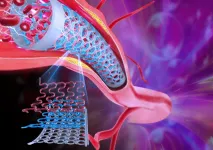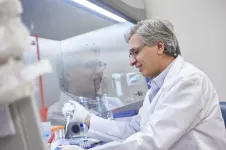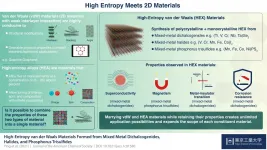Chip inserted under the skin may better identify patients at risk of recurrent stroke
STROKE AF trial results indicate that an inserted chip can improve detection of irregular heart rate
2021-06-01
(Press-News.org) BOSTON - For patients who have experienced certain common types of stroke, a small chip inserted under the skin may help physicians predict their likelihood of experiencing a second stroke, and therefore their likelihood of benefiting from preventive therapy. The findings come from a recent clinical trial published in the END
ELSE PRESS RELEASES FROM THIS DATE:
Self-aware materials build the foundation for living structures
2021-06-01
From the biggest bridges to the smallest medical implants, sensors are everywhere, and for good reason: The ability to sense and monitor changes before they become problems can be both cost-saving and life-saving.
To better address these potential threats, the Intelligent Structural Monitoring and Response Testing (iSMaRT) Lab at the University of Pittsburgh Swanson School of Engineering has designed a new class of materials that are both sensing mediums and nanogenerators, and are poised to revolutionize the multifunctional material technology big and small.
The research, recently published in Nano Energy, describes a new metamaterial system that ...
Researchers develop proof-of-concept treatment that elevates adult and fetal hemoglobin
2021-06-01
Philadelphia, June 1, 2021--Researchers at Children's Hospital of Philadelphia (CHOP) have developed a proof-of-concept treatment for blood disorders like sickle cell disease and beta-thalassemia that could raise hemoglobin levels by activating production of both fetal and adult hemoglobin. Using a viral vector engineered to reactivate fetal hemoglobin production, suppress mutant hemoglobin, and supply functional adult hemoglobin, the researchers developed an approach that could produce more hemoglobin through a single vector. The results were published in Haematologica.
"Until now, researchers have been exploring one of two approaches to treating blood disorders ...
Best of both worlds: High entropy meets low dimensions, opens up infinite possibilities
2021-06-01
The discovery of graphene, a 2D layered form of carbon, once caused a paradigm shift in science and technology like no other. As this wonder material drew attention from material scientists around the world, it spurred research on other materials that were structurally similar, such as "van der Waals materials", which comprise strongly-bonded 2D atomic layers that are held together by weak interlayer interactions called "van der Waals forces". These materials quickly caught on because they were highly conducive to structural modifications, such as stacking, twisting, and insertion of foreign molecules between layers, which gave them interesting physical properties ...
Early bird or night owl? Study links shift worker sleep to 'chronotype'
2021-06-01
Getting enough sleep can be a real challenge for shift workers affecting their overall health. But what role does being an early bird or night owl play in getting good rest? Researchers from McGill University find a link between chronotype and amount of sleep shift workers can get with their irregular schedules.
"Some people seem to be hardwired to sleep early, while others tend to sleep late. This preference, called chronotype, is modulated by our circadian system - each person's unique internal timekeeper," says lead author Diane B. Boivin, a Professor in the Department of Psychiatry at McGill University.
Their study published in Sleep is the first to examine the relationship between ...
2D natural clay offers a platform for machine learning algorithm
2021-06-01
Algorism plays a significant role in predicting future states of a system. Particularly, non-Markov chain algorithm has been widely applied in epidemic spreading processes, social and man-made memory networks, the environment-related quantum entangled states, and artificial algorisms such as face pose tracking. Traditionally, a large number of memories and computing cells are integrated to achieve these goals by software algorisms, showing high complexity. In the paper published in Science Bulletin, a group led by Bilu Liu and Hui-Ming Cheng from Tsinghua-Berkeley Shenzhen Institute (TBSI) of Tsinghua University has realized a non-Markov chain algorithm in a single resistive random access memory (RRAM) based on 2D mineral material ...
How the major Swedish forest fire of 2014 affected the ecosystem
2021-06-01
Swedish researchers from institutions including Uppsala University have spent four years gathering data from the areas affected by the major forest fire of 2014. In their study of how the ecosystem as a whole has been altered, they could see that water quality in watercourses quickly returned to normal, while forested areas continued to lose carbon for many years after the fire.
The consequences of major forest fires remain poorly studied in Northern Europe. To improve this situation, researchers from Uppsala University, the Swedish University of Agricultural Sciences (SLU) and the Swedish Meteorological ...
Trust among corvids
2021-06-01
Siberian jays are group living birds within the corvid family that employ a wide repertoire of calls to warn each other of predators. Sporadically, however, birds use one of these calls to trick their neighbouring conspecifics and gain access to their food. Researchers from the universities of Konstanz (Germany), Wageningen (Netherlands), and Zurich (Switzerland) have now examined how Siberian jays avoid being deceived by their neighbours. The study, published in the journal Science Advances, shows that these birds have great trust in the warning calls from members of their own group, but mainly ignore such ...
How news coverage affects public trust in science
2021-06-01
News media reports about scientific failures that do not recognize the self-correcting nature of science can damage public perceptions of trust and confidence in scientific work, according to findings by researchers at the Annenberg Public Policy Center (APPC) of the University of Pennsylvania and the University at Buffalo, the State University of New York.
News stories about science follow several specific narratives, the researchers write in a new study in the journal Public Understanding of Science. One is that science is "in crisis" or "broken," a narrative driven in recent years by reports of unsuccessful efforts to replicate findings in ...
Mini bone marrow model predicts response to blood disorder treatment
2021-06-01
A new miniature 3D model of human bone marrow has been described today in the open-access eLife journal.
The model may help clinicians predict which patients will benefit from a new therapy for blood platelet disorders, such as Inherited Thrombocytopenias - a group of familial disorders that inhibit the production of platelets. It could also enable further study of these disorders and give scientists a new tool to test experimental treatments.
Platelets are cells that are necessary for the blood to clot and stop bleeding. Having too few platelets can lead to internal or serious bleeding after surgery or injuries, which is usually treated with therapies that cause clotting. Recent studies have shown that a drug called Eltrombopag increases ...
Foster care, homelessness are higher education hurdles
2021-06-01
A college education is estimated to add $1 million to a person's lifetime earning potential, but for some students the path to earning one is riddled with obstacles. That journey is even more difficult for students who have been in the foster care system or experienced homelessness, according to a new study from the University of Georgia.
But the more college administrators and faculty know about these students' problems, the more they can do to ease the burden.
Getting into universities in the first place can frequently be a challenge for students who've had unstable home lives, said David Meyers, co-author of the study.
"Research tells us that every time a student moves from one foster care placement to another, they lose six months of educational ...
LAST 30 PRESS RELEASES:
Why nail-biting, procrastination and other self-sabotaging behaviors are rooted in survival instincts
Regional variations in mechanical properties of porcine leptomeninges
Artificial empathy in therapy and healthcare: advancements in interpersonal interaction technologies
Why some brains switch gears more efficiently than others
UVA’s Jundong Li wins ICDM’S 2025 Tao Li Award for data mining, machine learning
UVA’s low-power, high-performance computer power player Mircea Stan earns National Academy of Inventors fellowship
Not playing by the rules: USU researcher explores filamentous algae dynamics in rivers
Do our body clocks influence our risk of dementia?
Anthropologists offer new evidence of bipedalism in long-debated fossil discovery
Safer receipt paper from wood
Dosage-sensitive genes suggest no whole-genome duplications in ancestral angiosperm
First ancient human herpesvirus genomes document their deep history with humans
Why Some Bacteria Survive Antibiotics and How to Stop Them - New study reveals that bacteria can survive antibiotic treatment through two fundamentally different “shutdown modes”
UCLA study links scar healing to dangerous placenta condition
CHANGE-seq-BE finds off-target changes in the genome from base editors
The Journal of Nuclear Medicine Ahead-of-Print Tip Sheet: January 2, 2026
Delayed or absent first dose of measles, mumps, and rubella vaccination
Trends in US preterm birth rates by household income and race and ethnicity
Study identifies potential biomarker linked to progression and brain inflammation in multiple sclerosis
Many mothers in Norway do not show up for postnatal check-ups
Researchers want to find out why quick clay is so unstable
Superradiant spins show teamwork at the quantum scale
Cleveland Clinic Research links tumor bacteria to immunotherapy resistance in head and neck cancer
First Editorial of 2026: Resisting AI slop
Joint ground- and space-based observations reveal Saturn-mass rogue planet
Inheritable genetic variant offers protection against blood cancer risk and progression
Pigs settled Pacific islands alongside early human voyagers
A Coral reef’s daily pulse reshapes microbes in surrounding waters
EAST Tokamak experiments exceed plasma density limit, offering new approach to fusion ignition
Groundbreaking discovery reveals Africa’s oldest cremation pyre and complex ritual practices
[Press-News.org] Chip inserted under the skin may better identify patients at risk of recurrent strokeSTROKE AF trial results indicate that an inserted chip can improve detection of irregular heart rate






